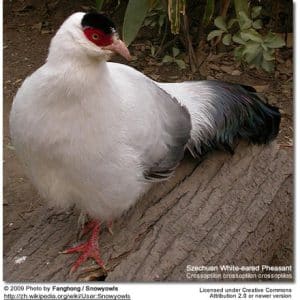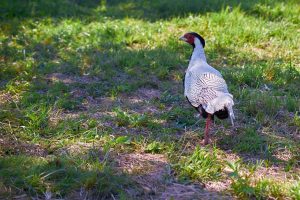White-eared Pheasant (Crossoptilon Crossoptilon)
The White-eared Pheasants (Crossoptilon crossoptilon) are native to China, where they are found in southeastern Tibet, western Szechuan, southern Qinghai, and northwestern Yunnan.
They prefer coniferous forests on rocky hillsides. In the summer, they can also be found in mixed forest areas up to the snow line.
Their status in the wild is considered vulnerable as habitat loss and hunting has taken its toll in many areas of their range. However, as their range is quite expansive, it is possible that there are stable and locally common populations in some of these areas.
Description:
This is a distinctively large, overall white pheasant, with a velvety black crown, red facial skin and dark tail. Unlike other members of the genus, the ear-tufts are quite small and they carry a smaller, less ornate tail.
Males and females are generally similar, but the hens tend to be smaller.
There are four subspecies generally recognized:
- Szechuan White-eared Pheasant, C. c. crossopitlon
- ID: Pure white chin, rest of body off-white, wing-coverts tinged with grey; primaries dark grey to brown.
- Dolan’s Pheasant, C. c. dolani
- ID: Ashy / pale grey overall with a white belly; wings are pale grey.
- Tibetan or Drouyni Pheasant,C. c. drouyni
- ID: Pure white body. There is some light grey on the mantle; wings are white.
- Yunnan Pheasants,C. c. lichiangense
- ID: Much like crossopitlon, but wings are lighter grey.
- Harman’s Eared Pheasant C. harmani, sometimes classed as a subspecies
Keeping and Breeding the White-eared Pheasant
The Drouyni and Szechuan sub-species are most commonly found in aviculture. The
They are hardy pheasants that can withstand cold temperatures very well. However, they will need protection from the heat and sun of the summer.
The Eared Pheasants are considered to be one of the calmest pheasant species and in captivity they often can be taught to go in and out of a coop every night like chicken – unlike most other pheasants who would simply take off. They should be provided a large, planted aviary.
The White-eared Pheasants should be kept in pairs. They are ready to breed in their second year. The breeding season starts in April to June. The hen lays 4 to 7 egg, which she incubates for 24 to 25 days.
Other Releated Web Links: Pheasant General Information … Pheasant Species … Pheasant Taxonomy … Breeding Pheasants … Pheasant Photo Gallery … Housing Pheasants … Pheasant Diseases






